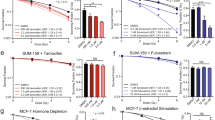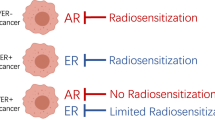Abstract
Cytotoxic agents linked to hormonal carriers provide new approaches to tumor therapy, and LH–RH receptors expressed by breast cancers can be used for targeting chemotherapeutic compounds. In the present study, large, advanced estrogen–independent MXT mouse mammary cancers were treated with cytotoxic LH–RH analog AN–152 containing doxorubicin (DOX) or AN–207 incorporating superactive derivative 2–pyrrolino–DOX (AN–201). These cytotoxic hybrid molecules were administered once i.v., close to their maximum tolerated doses, at various time intervals after transplantation of tumors. The cytotoxic LH–RH analogs and the radicals alone, given at earlier stages of tumor development, inhibited growth of MXT cancers. Cytotoxic LH–RH conjugate AN–207 had significantly stronger effect than its respective cytotoxic radical, particularly when larger tumors were treated, causing 95, 89, 100 and 96 tumor growth reduction when administered on days 1, 7, 10 or 14, respectively. AN–152, AN–201, and DOX, given on day 14, were virtually ineffective. Histological characteristics of tumor cell proliferation and cell death were analyzed in large MXT cancers 1–4 days after treatment with AN–207 and AN–201. AgNOR scores were decreased and apoptotic indices increased after treatment of tumors with AN–207 or AN–201, but enhanced apoptosis and decreased AgNOR numbers persisted longer in the case of AN–207. In contrast to AN–201, AN–207 also increased the extent of necrosis in tumors. In conclusion, on the basis of its powerful inhibitory effect on the aggressive MXT mouse mammary tumor, the cytotoxic LH–RH analog AN–207 could be considered for treatment of advanced human mammary carcinomas that express LH–RH receptors.
Similar content being viewed by others
References
Landis SH, Murray T, Bolden S, Wingo PA: Cancer Statistics, 1998. CA Cancer J Clin 48: 6–29, 1998
Chu KC, Tarone RE, Kessler LG, Ries LAG, Hankey BF, Miller BA, Edwards BK: Recent trends in U.S. Breast cancer incidence, survival and mortality rates. J Natl Cancer Inst 88: 1571–1579, 1996
Smith G, Henderson IC: New treatments for breast cancer. Semin Oncol 23: 506–528, 1996
Goldhirsch A, Gelber D: Endocrine therapies of breast cancer. Semin Oncol 23: 494–505, 1996
Hudis CA, Norton L: Adjuvant drug therapy for operable breast cancer. Semin Oncol 23: 475–493, 1996
Gehl J, Boesgaard M, Paaske T, Jensen BV, Dombernowsky P: Paclitaxel and doxorubicin in metastatic breast cancer. Semin Oncol 23 (Suppl 15): 35–38, 1996
Hortobagyi GN: Anthracyclines in the treatment of cancer. Drugs 54 (Suppl 4): 1–7, 1997
Awada A, Van Vreckem A, Paridaens R, Bruning PF, Klijn J, Tomiak E, Vinholes J, Roy JA, Kusenda Z, Hoctin Boes G, Van Glabbeke M, Piccart MJ: EORTC-IDBBC (Investigational Drug Branch for Breast Cancer): 5 years of European collaboration in new drug development for breast cancer. Eur J Cancer 33: 1173–1176, 1997
Begent RHJ: UICC/CRC conference on targeted cancer therapy. Int J Cancer 55: 355–358, 1993
Magrath IT: Targeted approaches to cancer therapy. Int J Cancer 56: 163–166, 1994
Schally AV, Nagy A, Szepeshazi K, Pinski J, Halmos G, Armatis P, Miyazaki M, Comaru-Schally AM, Yano T, Emons G: LH-RH analogs with cytotoxic radicals. In: Filicori M, Flamigni C (eds) Treatment with Gn-RH analogs: controversies and perspectives. Parthenon, Carnforth, UK, 1996, pp 33–44
Siegall CB: Targeted toxins as anticancer agents. Cancer 74: 1006–1012, 1994
Schally AV: Hypothalamic hormones: from neuroendocrinology to cancer therapy. Anticancer Drugs 5: 115–130, 1994
Nagy A, Armatis P, Schally AV: High yield conversion of doxorubicin to 2-pyrrolinodoxorubicin, an analog 500- 1000 times more potent: Structure-activity relationship of daunosamine-modified derivatives of doxorubicin. Proc Natl Acad Sci USA 93: 2464–2469, 1996
Nagy A, Schally AV, Armatis P, Szepeshazi K, Halmos G, Kovacs M, Zarandi M, Groot K, Miyazaki M, Jungwirth A, Horvath J: Cytotoxic analogs of luteinizing hormone-releasing hormone containing doxorubicin or 2-pyrrolinodoxorubicin, a derivative 500-1000 times more potent. Proc Natl Acad Sci USA 93: 7269–7273, 1996
Szepeshazi K, Schally A, Nagy A, Halmos G, Groot K: Targeted cytotoxic luteinizing hormone releasing hormone (LHRH) analogs inhibit growth of estrogen-independent MXT mouse mammary cancers in vivo by decreasing cell proliferation and inducing apoptosis. Anticancer Drugs 8: 974–987, 1997
Clarke R: Animal models of breast cancer: Their diversity and role in biomedical research. Breast Cancer Res Treat 39: 1–6, 1996
Szepeshazi K, Milovanovic S, Lapis K, Groot K, Schally AV: Growth inhibition of estrogen-independent MXT mouse mammary carcinomas in mice treated with an agonist or antagonist of LH-RH, an analog of somatostatin, or a combination. Breast Cancer Res Treat 21: 181–192, 1992
Szepeshazi K, Korkut E, Schally AV: Decrease in AgNOR number in Dunning R-3327 prostate cancer after treatment with LH-RH agonist and antagonist. Am J Pathol 138: 1273–1277, 1991
Schally AV, Comaru-Schally AM: Hypothalamic and other peptide hormones. In: Holland JF, Frei E, III, Bast RC, Jr, Kufe DE, Morton DL, Weichselbaum RR, (eds) Cancer Medicine, 4th edn.Williams and Wilkins, Baltimore, MD, 1997, pp 1067–1086
Eidne KA, Flanagan CA, Harris NS, Millar RP: Gonadotropin-releasing hormone (GnRH)-binding sites in human breast cancer cell lines and inhibitory effects of GnRH antagonists. J Clin Endocrinol Metab 64: 425–432, 1987
Varga JM: Hormone-drug conjugates. Methods Enzymol 112: 259–269, 1985
Kovacs M, Schally AV, Nagy A, Koppan M, Groot K: Recovery of pituitary function after treatment with a targeted cytotoxic analog of luteinizing hormone-releasing hormone. Proc Natl Acad Sci USA 94: 1420–1425, 1997
Koppan M, Nagy A, Schally AV, Plonowski A, Halmos G, Arencibia JM, Groot K: Targeted cytotoxic analog of luteinizing hormone-releasing hormone AN-207 inhibits the growth of PC-82 human prostate cancer in nude mice. Prostate 38: 151–158, 1999
Szepeshazi K, Schally AV, Halmos G, Szoke B, Groot K, Nagy A: Effect of a cytotoxic analog of LH-RH (T-98) on the growth of estrogen dependent MXT mouse mammary cancers: correlations between growth characteristics and EGF receptor content of tumors. Breast Cancer Res Treat 40: 129–139, 1996
Miyazaki M, Nagy A, Schally AV, Lamharzi N, Halmos G, Szepeshazi K, Groot K, Armatis P: Growth inhibition of human ovarian cancers by cytotoxic analogues of luteinizing hormone-releasing hormone. J Natl Cancer Inst 89: 1803–1809, 1997
Derenzini M, Trere D: Importance of interphase nucleolar organizer regions in tumor pathology. Virchows Arch B Cell Pathol 61: 1–8, 1991
Granville DJ, Carthy CM, Hunt DWC, McManus BM: Apoptosis: Molecular aspects of cell death and disease. Lab Invest 78: 893–913, 1998
Mansat V, Laurent G, Levade T, Bettaieb A, Jaffrezou J-P: The protein kinase C activators phorbol esters and phosphatidylserine inhibit neutral sphingomyelinase activation, ceramide generation, and apoptosis triggered by daunorubicin. Cancer Res 57: 5300–5304, 1997
Kiaris H, Schally AV: Apoptosis vs. necrosis: Which should be the aim of cancer therapy? Proc Soc Exper Biol Med 222:87–88, 1999
Author information
Authors and Affiliations
Rights and permissions
About this article
Cite this article
Szepeshazi, K., Schally, A.V. & Nagy, A. Effective treatment of advanced estrogen–independent MXT mouse mammary cancers with targeted cytotoxic LH–RH analogs. Breast Cancer Res Treat 56, 265–274 (1999). https://doi.org/10.1023/A:1006267327007
Issue Date:
DOI: https://doi.org/10.1023/A:1006267327007




